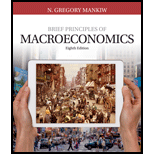
Example of human capital.
Answer to Problem 1CQQ
Option ‘b’ is the correct answer.
Explanation of Solution
Option (b)
Education is an important human capital because it represents an expenditure of resources at one time to raise productivity in the future. Since studying latest developments in computer programming enhanced his productivity that enabled him to attain higher income in future, it is considered A human capital. Thus, option ‘b’ is correct.
Option (a)
Compensating differential is the difference in wages that arise to offset the nonmonetary characteristics of different jobs. So option ‘a’ is incorrect.
Option (c)
Under signaling, the choice of being a math teacher is better than spending time for studying. Hence option ‘c’ is incorrect.
Option (d)
There is no mention about receiving above the equilibrium level wages; option ‘d’ is incorrect.
Concept Introduction:
Human capital: It is the accumulations of investments in people in the form of education, on-the-job training, etc.
Compensating differential: It is the difference in wages that arise to offset the nonmonetary characteristics of different jobs.
Efficiency wages: It is the above-equilibrium wages paid by firms to increase worker productivity.
Want to see more full solutions like this?
Chapter 19 Solutions
Bundle: Principles Of Economics, Loose-leaf Version, 8th + Lms Integrated Mindtap Economics, 1 Term (6 Months) Printed Access Card
- Use a game tree to illustrate why an aircraft manufacturer may price below the current marginal cost in the short run if it has a steep learning curve. (Hint: Show that learning by doing lowers its cost in the second period.) Part 2 Assume for simplicity the game tree is illustrated in the figure to the right. Pricing below marginal cost reduces profits but gives the incumbent a cost advantage over potential rivals. What is the subgame perfect Nash equilibrium?arrow_forwardAnswerarrow_forwardM” method Given the following model, solve by the method of “M”. (see image)arrow_forward
- As indicated in the attached image, U.S. earnings for high- and low-skill workers as measured by educational attainment began diverging in the 1980s. The remaining questions in this problem set use the model for the labor market developed in class to walk through potential explanations for this trend. 1. Assume that there are just two types of workers, low- and high-skill. As a result, there are two labor markets: supply and demand for low-skill workers and supply and demand for high-skill workers. Using two carefully drawn labor-market figures, show that an increase in the demand for high skill workers can explain an increase in the relative wage of high-skill workers. 2. Using the same assumptions as in the previous question, use two carefully drawn labor-market figures to show that an increase in the supply of low-skill workers can explain an increase in the relative wage of high-skill workers.arrow_forwardPublished in 1980, the book Free to Choose discusses how economists Milton Friedman and Rose Friedman proposed a one-sided view of the benefits of a voucher system. However, there are other economists who disagree about the potential effects of a voucher system.arrow_forwardThe following diagram illustrates the demand and marginal revenue curves facing a monopoly in an industry with no economies or diseconomies of scale. In the short and long run, MC = ATC. a. Calculate the values of profit, consumer surplus, and deadweight loss, and illustrate these on the graph. b. Repeat the calculations in part a, but now assume the monopoly is able to practice perfect price discrimination.arrow_forward
 Economics (MindTap Course List)EconomicsISBN:9781337617383Author:Roger A. ArnoldPublisher:Cengage Learning
Economics (MindTap Course List)EconomicsISBN:9781337617383Author:Roger A. ArnoldPublisher:Cengage Learning









